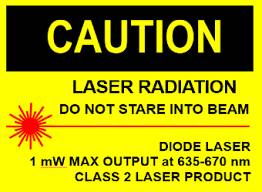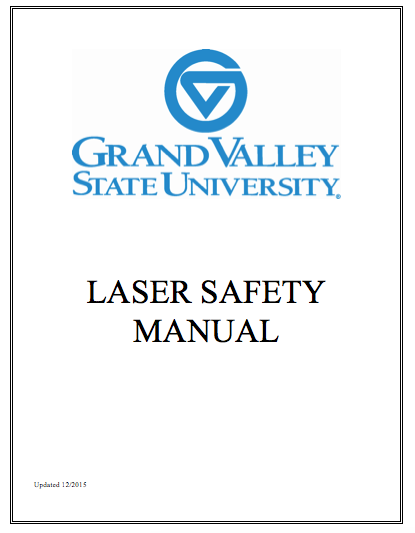Laser Safety
Grand Valley State University is committed to providing a safe work environment for the health and well-being of its employees and students. We have developed the Laser Safety Manual to support that commitment. The Manual contains policies and procedures, prepared in accordance with laser safety regulations and guidelines to ensure safe use of lasers in GVSU's laboratories and classrooms.
The Manual contains general guidelines and information about GVSUs policies, safe practices, emergency response actions, for using Class 3b and 4 lasers at GVSU. It does not contain procedures and response actions that apply to specific laboratories within a particular building. In cases where hazards are such that a Laboratory Specific Plan is necessary, those will be prepared and maintained by either the Laboratory Supervisor or Principal Investigator.
Faculty and staff, including student employees, working in laboratory areas should become familiar with the information covered in this document. In the event of a lab related emergency, response actions and reporting procedures are provided assure compliance with regulatory requirements and GVSU policies and procedures. Emergency contact numbers should be posted in each lab.
GVSU expects students and faculty who use lasers in experimental research to become familiar with the basic information contained in this Plan. GVSU has delegated the responsibility for providing students with a safe learning environment in academic courses to the appropriate academic administrator and faculty and staff who work with or instruct the students in the laboratories. The Laser Safety Program is administered by the Office of Laboratory Safety and overseen by GVSU's Laser Safety Committee (supported through Office of Research Compliance and Integrity).
Laser Pointers
Laser pointers have become a very useful tool for presentations and typically present very little risk. However, high powered or improperly labeled lasers can present a hazard to faculty and students. Below are some things to consider before using a laser in your classroom:
- Classification: Lasers fall into four major hazard categories called the laser hazard classifications (Class 1-4). Any laser rated as Class 3b or 4 must be approved by GVSU's Laser Safety Committee. Only Class 1, 2, or 3R (or 3A) laser pointers are permitted for use in classrooms. When possible, select a Class 2 laser pointer. Red/orange pointers are preferred, as they have been shown to have lower eye sensitivity than green lasers.
- Labeling: All lasers pointers should have a label from the manufacturer identifying its hazard classification. Any laser with a missing label should not be used. Older lasers or those purchased from less reputable retailers may have inaccurate hazard classifications. If your laser is not labeled or you feel its rating may be inaccurate contact Laboratory Safety for power testing.
- Safe Use: Never stare into a laser or shine it in the direction of the audience. Avoid pointing the laser toward shiny objects. Never view a laser through optics such as binoculars or a microscope. The laser should turn off when power button released (can't be locked on). Never point the laser at aircraft, cars, buses, buildings or law enforcement officers.
GVSU has tools to measure laser output. If your laser is unlabelled, or if you feel the label is inaccurate, contact Environmental Health and Safety to arrange testing.


Laser Projectors
Many recent high-brightness projectors intended for use with ordinary projection screens use blocks of laser diodes as their main light sources. While these “laser projectors” do contain lasers, they are not generally subject to laser safety regulations because the light they emit does not create hazards normally associated with laser sources.
If a laser projector’s manual or labeling indicates that it complies with IEC standard 62471-5, and that it falls within “risk group” RG0, RG1, or RG2 of that standard, then no special laser-safety precautions are necessary. It does still produce hazards like those associated with any bright light source, and the projector must be installed and used according to the instructions in its manual. Most laser projectors fitting this description will also be marked “Class 1 Laser Product.” Sample product markings for a projector of this type are shown to the left.
Devices under IEC standard 62471-5 marked ‘RG3’ are not intended for consumer use and will have more stringent installation and use requirements. Similarly, devices marked with a “Laser Product” class higher than 1 are subject to laser safety regulations. The Laser Safety Committee is prepared to offer advice about installation and use of such devices. Devices in Laser Product classes 3b and 4 have special training and inventory requirements and the purchaser is required to contact the Committee prior to installation and use. (Projectors intended for laser light shows are an example.)
For more information, see
- The FDA page on the topic: https://www.fda.gov/regulatory-information/search-fda-guidance-documents/classification-and-requirements-laser-illuminated-projectors-lips-laser-notice-no-57
- An industry-association page describing the projectors and their hazard regulations: https://www.lipainfo.org/laser-illumination-sources/laser-regulations/
- A paper evaluating the eye hazards of RG2 projectors: K. Schulmeister, “Risk of retinal injury from “Risk Group 2” laser illuminated projectors”, Journal of Laser Applications 28, 042002 (2016) (https://lia.scitation.org/doi/full/10.2351/1.4954930)
To reach the Laser Safety Committee, contact Environmental Health and Safety.


